Clinical Incident Analysis: Nursing Case Study - 401021 Assessment 2
VerifiedAdded on 2023/06/07
|6
|1757
|260
Case Study
AI Summary
This case study examines a clinical incident involving an 81-year-old patient, Patient A, who presented with breathlessness and was later admitted to the hospital. The case focuses on the actions of Registered Nurse John. Despite the patient's deteriorating condition, including high respiratory and heart rates, refusal of food and liquid, and other concerning symptoms, the nurse delayed action and failed to adequately document observations or communicate concerns to the Clinical Nurse Manager. The patient ultimately died from septicaemia. The case study analyzes the nurse's responsibilities, the importance of immediate action, proper documentation, and professional behavior in emergency situations. It highlights the significance of adhering to national safety and quality health service standards and the impact of professional conduct on patient outcomes, emphasizing the need for quick decision-making, thorough assessment, and effective communication to ensure patient safety and well-being. The study concludes with a personal reflection on the importance of proactive nursing care and the consequences of inaction.
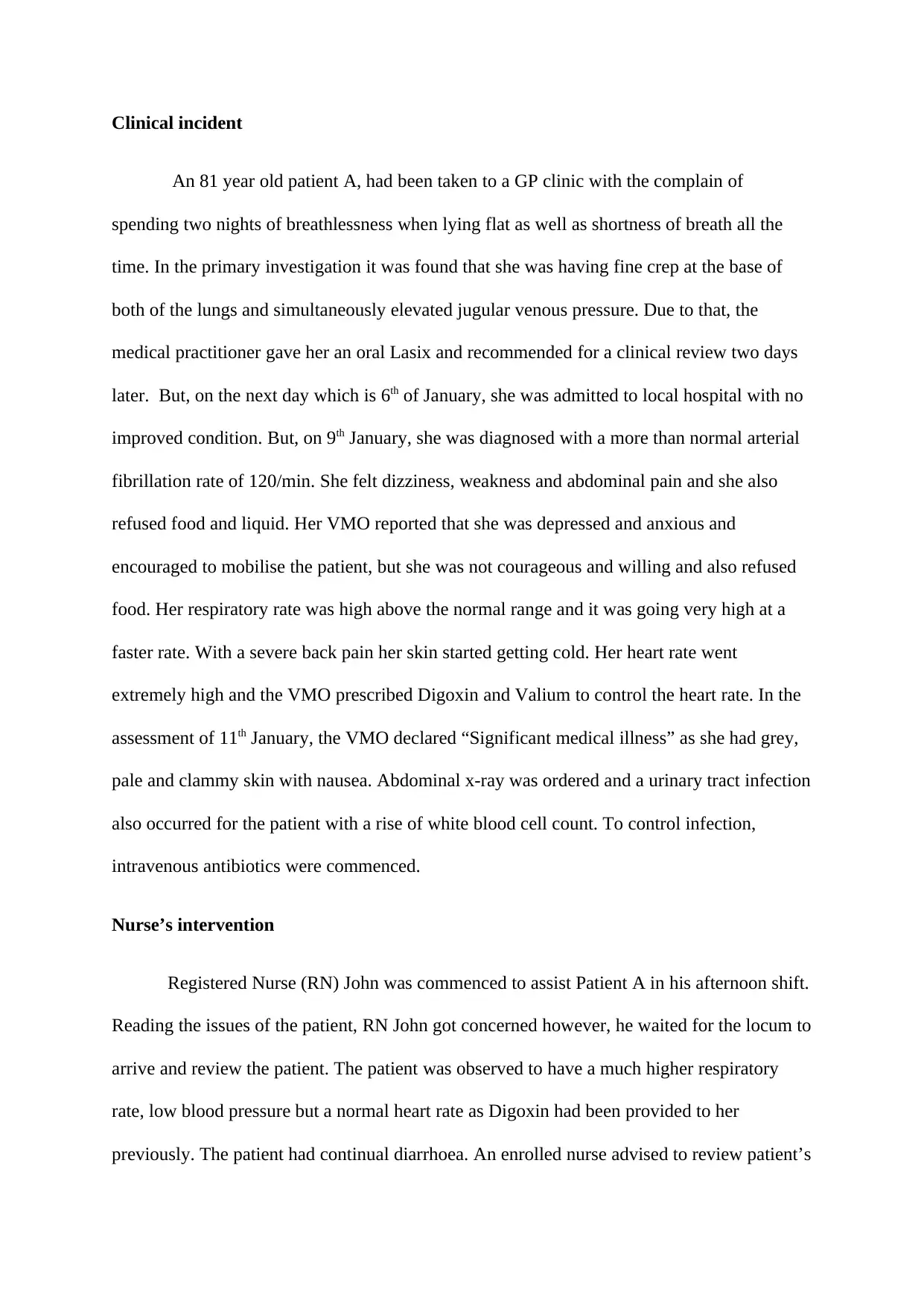
Clinical incident
An 81 year old patient A, had been taken to a GP clinic with the complain of
spending two nights of breathlessness when lying flat as well as shortness of breath all the
time. In the primary investigation it was found that she was having fine crep at the base of
both of the lungs and simultaneously elevated jugular venous pressure. Due to that, the
medical practitioner gave her an oral Lasix and recommended for a clinical review two days
later. But, on the next day which is 6th of January, she was admitted to local hospital with no
improved condition. But, on 9th January, she was diagnosed with a more than normal arterial
fibrillation rate of 120/min. She felt dizziness, weakness and abdominal pain and she also
refused food and liquid. Her VMO reported that she was depressed and anxious and
encouraged to mobilise the patient, but she was not courageous and willing and also refused
food. Her respiratory rate was high above the normal range and it was going very high at a
faster rate. With a severe back pain her skin started getting cold. Her heart rate went
extremely high and the VMO prescribed Digoxin and Valium to control the heart rate. In the
assessment of 11th January, the VMO declared “Significant medical illness” as she had grey,
pale and clammy skin with nausea. Abdominal x-ray was ordered and a urinary tract infection
also occurred for the patient with a rise of white blood cell count. To control infection,
intravenous antibiotics were commenced.
Nurse’s intervention
Registered Nurse (RN) John was commenced to assist Patient A in his afternoon shift.
Reading the issues of the patient, RN John got concerned however, he waited for the locum to
arrive and review the patient. The patient was observed to have a much higher respiratory
rate, low blood pressure but a normal heart rate as Digoxin had been provided to her
previously. The patient had continual diarrhoea. An enrolled nurse advised to review patient’s
An 81 year old patient A, had been taken to a GP clinic with the complain of
spending two nights of breathlessness when lying flat as well as shortness of breath all the
time. In the primary investigation it was found that she was having fine crep at the base of
both of the lungs and simultaneously elevated jugular venous pressure. Due to that, the
medical practitioner gave her an oral Lasix and recommended for a clinical review two days
later. But, on the next day which is 6th of January, she was admitted to local hospital with no
improved condition. But, on 9th January, she was diagnosed with a more than normal arterial
fibrillation rate of 120/min. She felt dizziness, weakness and abdominal pain and she also
refused food and liquid. Her VMO reported that she was depressed and anxious and
encouraged to mobilise the patient, but she was not courageous and willing and also refused
food. Her respiratory rate was high above the normal range and it was going very high at a
faster rate. With a severe back pain her skin started getting cold. Her heart rate went
extremely high and the VMO prescribed Digoxin and Valium to control the heart rate. In the
assessment of 11th January, the VMO declared “Significant medical illness” as she had grey,
pale and clammy skin with nausea. Abdominal x-ray was ordered and a urinary tract infection
also occurred for the patient with a rise of white blood cell count. To control infection,
intravenous antibiotics were commenced.
Nurse’s intervention
Registered Nurse (RN) John was commenced to assist Patient A in his afternoon shift.
Reading the issues of the patient, RN John got concerned however, he waited for the locum to
arrive and review the patient. The patient was observed to have a much higher respiratory
rate, low blood pressure but a normal heart rate as Digoxin had been provided to her
previously. The patient had continual diarrhoea. An enrolled nurse advised to review patient’s
Paraphrase This Document
Need a fresh take? Get an instant paraphrase of this document with our AI Paraphraser
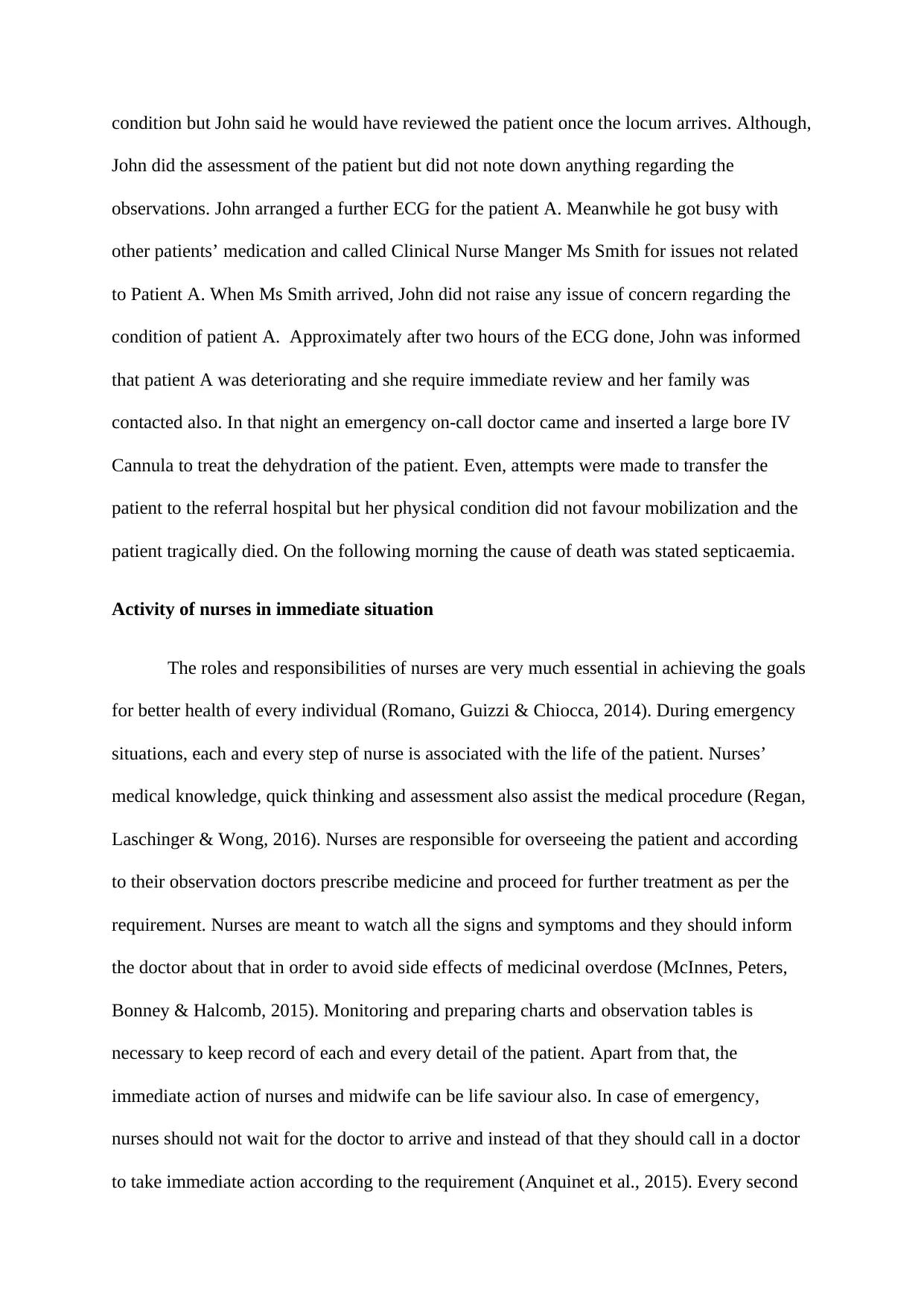
condition but John said he would have reviewed the patient once the locum arrives. Although,
John did the assessment of the patient but did not note down anything regarding the
observations. John arranged a further ECG for the patient A. Meanwhile he got busy with
other patients’ medication and called Clinical Nurse Manger Ms Smith for issues not related
to Patient A. When Ms Smith arrived, John did not raise any issue of concern regarding the
condition of patient A. Approximately after two hours of the ECG done, John was informed
that patient A was deteriorating and she require immediate review and her family was
contacted also. In that night an emergency on-call doctor came and inserted a large bore IV
Cannula to treat the dehydration of the patient. Even, attempts were made to transfer the
patient to the referral hospital but her physical condition did not favour mobilization and the
patient tragically died. On the following morning the cause of death was stated septicaemia.
Activity of nurses in immediate situation
The roles and responsibilities of nurses are very much essential in achieving the goals
for better health of every individual (Romano, Guizzi & Chiocca, 2014). During emergency
situations, each and every step of nurse is associated with the life of the patient. Nurses’
medical knowledge, quick thinking and assessment also assist the medical procedure (Regan,
Laschinger & Wong, 2016). Nurses are responsible for overseeing the patient and according
to their observation doctors prescribe medicine and proceed for further treatment as per the
requirement. Nurses are meant to watch all the signs and symptoms and they should inform
the doctor about that in order to avoid side effects of medicinal overdose (McInnes, Peters,
Bonney & Halcomb, 2015). Monitoring and preparing charts and observation tables is
necessary to keep record of each and every detail of the patient. Apart from that, the
immediate action of nurses and midwife can be life saviour also. In case of emergency,
nurses should not wait for the doctor to arrive and instead of that they should call in a doctor
to take immediate action according to the requirement (Anquinet et al., 2015). Every second
John did the assessment of the patient but did not note down anything regarding the
observations. John arranged a further ECG for the patient A. Meanwhile he got busy with
other patients’ medication and called Clinical Nurse Manger Ms Smith for issues not related
to Patient A. When Ms Smith arrived, John did not raise any issue of concern regarding the
condition of patient A. Approximately after two hours of the ECG done, John was informed
that patient A was deteriorating and she require immediate review and her family was
contacted also. In that night an emergency on-call doctor came and inserted a large bore IV
Cannula to treat the dehydration of the patient. Even, attempts were made to transfer the
patient to the referral hospital but her physical condition did not favour mobilization and the
patient tragically died. On the following morning the cause of death was stated septicaemia.
Activity of nurses in immediate situation
The roles and responsibilities of nurses are very much essential in achieving the goals
for better health of every individual (Romano, Guizzi & Chiocca, 2014). During emergency
situations, each and every step of nurse is associated with the life of the patient. Nurses’
medical knowledge, quick thinking and assessment also assist the medical procedure (Regan,
Laschinger & Wong, 2016). Nurses are responsible for overseeing the patient and according
to their observation doctors prescribe medicine and proceed for further treatment as per the
requirement. Nurses are meant to watch all the signs and symptoms and they should inform
the doctor about that in order to avoid side effects of medicinal overdose (McInnes, Peters,
Bonney & Halcomb, 2015). Monitoring and preparing charts and observation tables is
necessary to keep record of each and every detail of the patient. Apart from that, the
immediate action of nurses and midwife can be life saviour also. In case of emergency,
nurses should not wait for the doctor to arrive and instead of that they should call in a doctor
to take immediate action according to the requirement (Anquinet et al., 2015). Every second
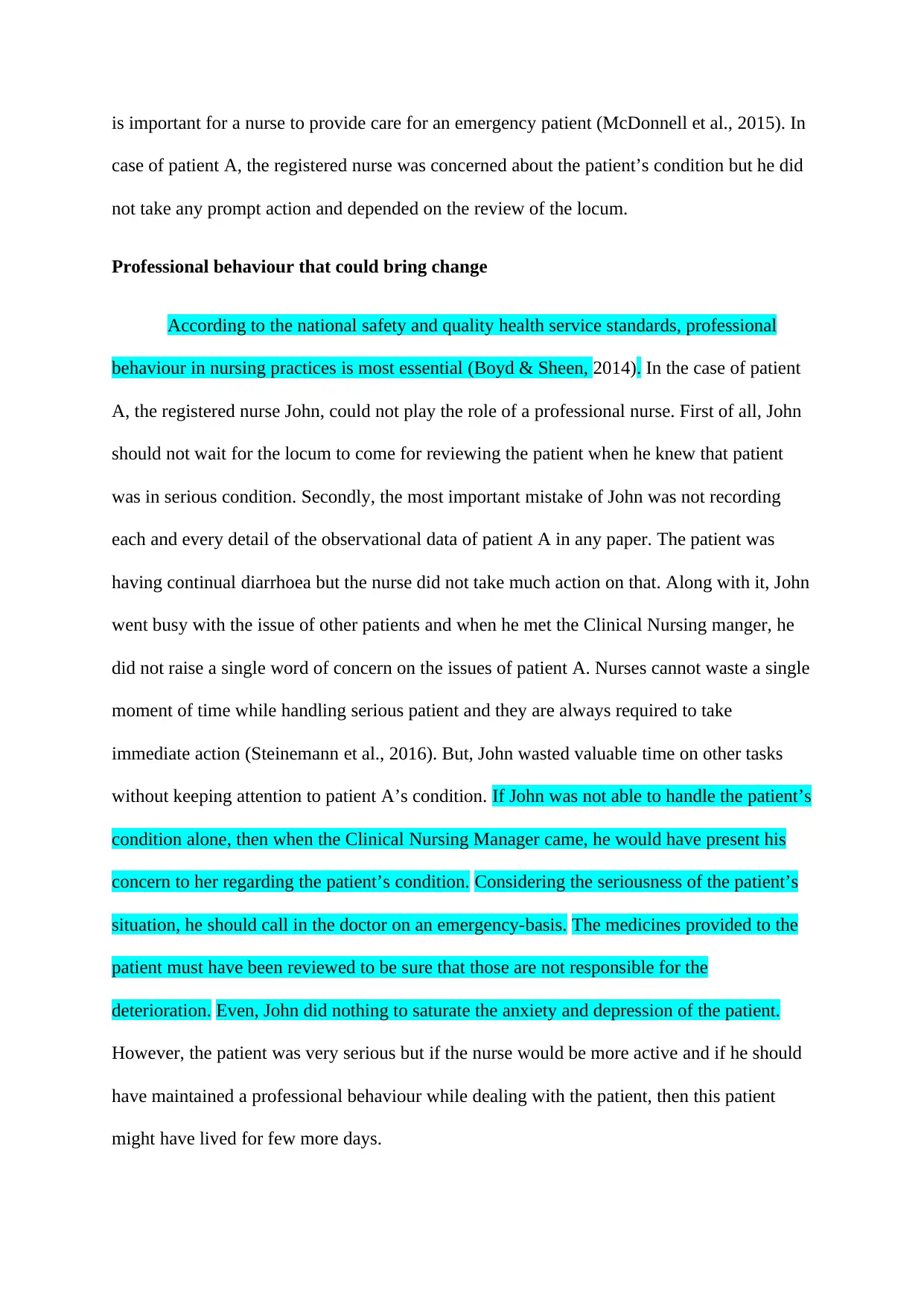
is important for a nurse to provide care for an emergency patient (McDonnell et al., 2015). In
case of patient A, the registered nurse was concerned about the patient’s condition but he did
not take any prompt action and depended on the review of the locum.
Professional behaviour that could bring change
According to the national safety and quality health service standards, professional
behaviour in nursing practices is most essential (Boyd & Sheen, 2014). In the case of patient
A, the registered nurse John, could not play the role of a professional nurse. First of all, John
should not wait for the locum to come for reviewing the patient when he knew that patient
was in serious condition. Secondly, the most important mistake of John was not recording
each and every detail of the observational data of patient A in any paper. The patient was
having continual diarrhoea but the nurse did not take much action on that. Along with it, John
went busy with the issue of other patients and when he met the Clinical Nursing manger, he
did not raise a single word of concern on the issues of patient A. Nurses cannot waste a single
moment of time while handling serious patient and they are always required to take
immediate action (Steinemann et al., 2016). But, John wasted valuable time on other tasks
without keeping attention to patient A’s condition. If John was not able to handle the patient’s
condition alone, then when the Clinical Nursing Manager came, he would have present his
concern to her regarding the patient’s condition. Considering the seriousness of the patient’s
situation, he should call in the doctor on an emergency-basis. The medicines provided to the
patient must have been reviewed to be sure that those are not responsible for the
deterioration. Even, John did nothing to saturate the anxiety and depression of the patient.
However, the patient was very serious but if the nurse would be more active and if he should
have maintained a professional behaviour while dealing with the patient, then this patient
might have lived for few more days.
case of patient A, the registered nurse was concerned about the patient’s condition but he did
not take any prompt action and depended on the review of the locum.
Professional behaviour that could bring change
According to the national safety and quality health service standards, professional
behaviour in nursing practices is most essential (Boyd & Sheen, 2014). In the case of patient
A, the registered nurse John, could not play the role of a professional nurse. First of all, John
should not wait for the locum to come for reviewing the patient when he knew that patient
was in serious condition. Secondly, the most important mistake of John was not recording
each and every detail of the observational data of patient A in any paper. The patient was
having continual diarrhoea but the nurse did not take much action on that. Along with it, John
went busy with the issue of other patients and when he met the Clinical Nursing manger, he
did not raise a single word of concern on the issues of patient A. Nurses cannot waste a single
moment of time while handling serious patient and they are always required to take
immediate action (Steinemann et al., 2016). But, John wasted valuable time on other tasks
without keeping attention to patient A’s condition. If John was not able to handle the patient’s
condition alone, then when the Clinical Nursing Manager came, he would have present his
concern to her regarding the patient’s condition. Considering the seriousness of the patient’s
situation, he should call in the doctor on an emergency-basis. The medicines provided to the
patient must have been reviewed to be sure that those are not responsible for the
deterioration. Even, John did nothing to saturate the anxiety and depression of the patient.
However, the patient was very serious but if the nurse would be more active and if he should
have maintained a professional behaviour while dealing with the patient, then this patient
might have lived for few more days.
⊘ This is a preview!⊘
Do you want full access?
Subscribe today to unlock all pages.

Trusted by 1+ million students worldwide
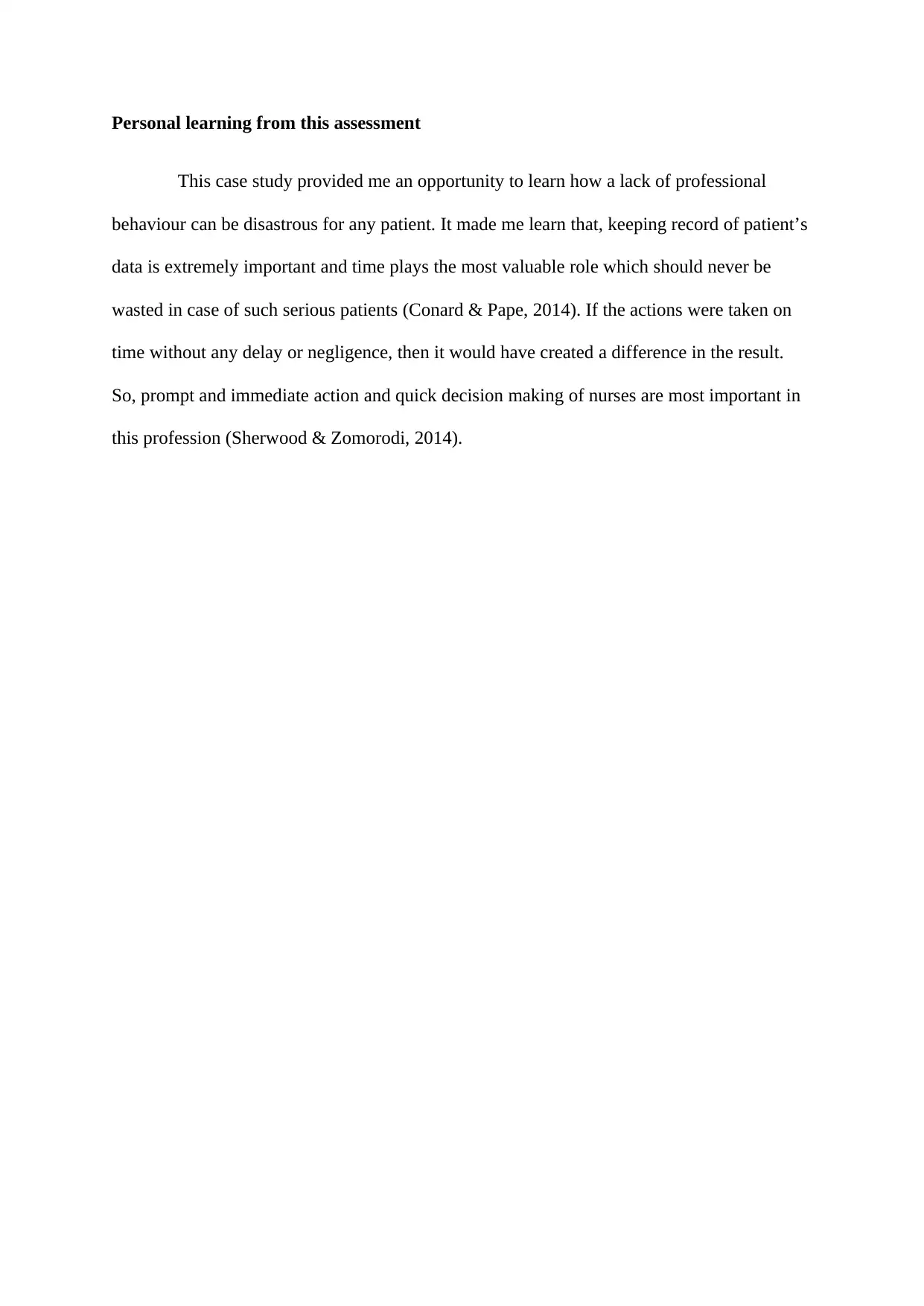
Personal learning from this assessment
This case study provided me an opportunity to learn how a lack of professional
behaviour can be disastrous for any patient. It made me learn that, keeping record of patient’s
data is extremely important and time plays the most valuable role which should never be
wasted in case of such serious patients (Conard & Pape, 2014). If the actions were taken on
time without any delay or negligence, then it would have created a difference in the result.
So, prompt and immediate action and quick decision making of nurses are most important in
this profession (Sherwood & Zomorodi, 2014).
This case study provided me an opportunity to learn how a lack of professional
behaviour can be disastrous for any patient. It made me learn that, keeping record of patient’s
data is extremely important and time plays the most valuable role which should never be
wasted in case of such serious patients (Conard & Pape, 2014). If the actions were taken on
time without any delay or negligence, then it would have created a difference in the result.
So, prompt and immediate action and quick decision making of nurses are most important in
this profession (Sherwood & Zomorodi, 2014).
Paraphrase This Document
Need a fresh take? Get an instant paraphrase of this document with our AI Paraphraser
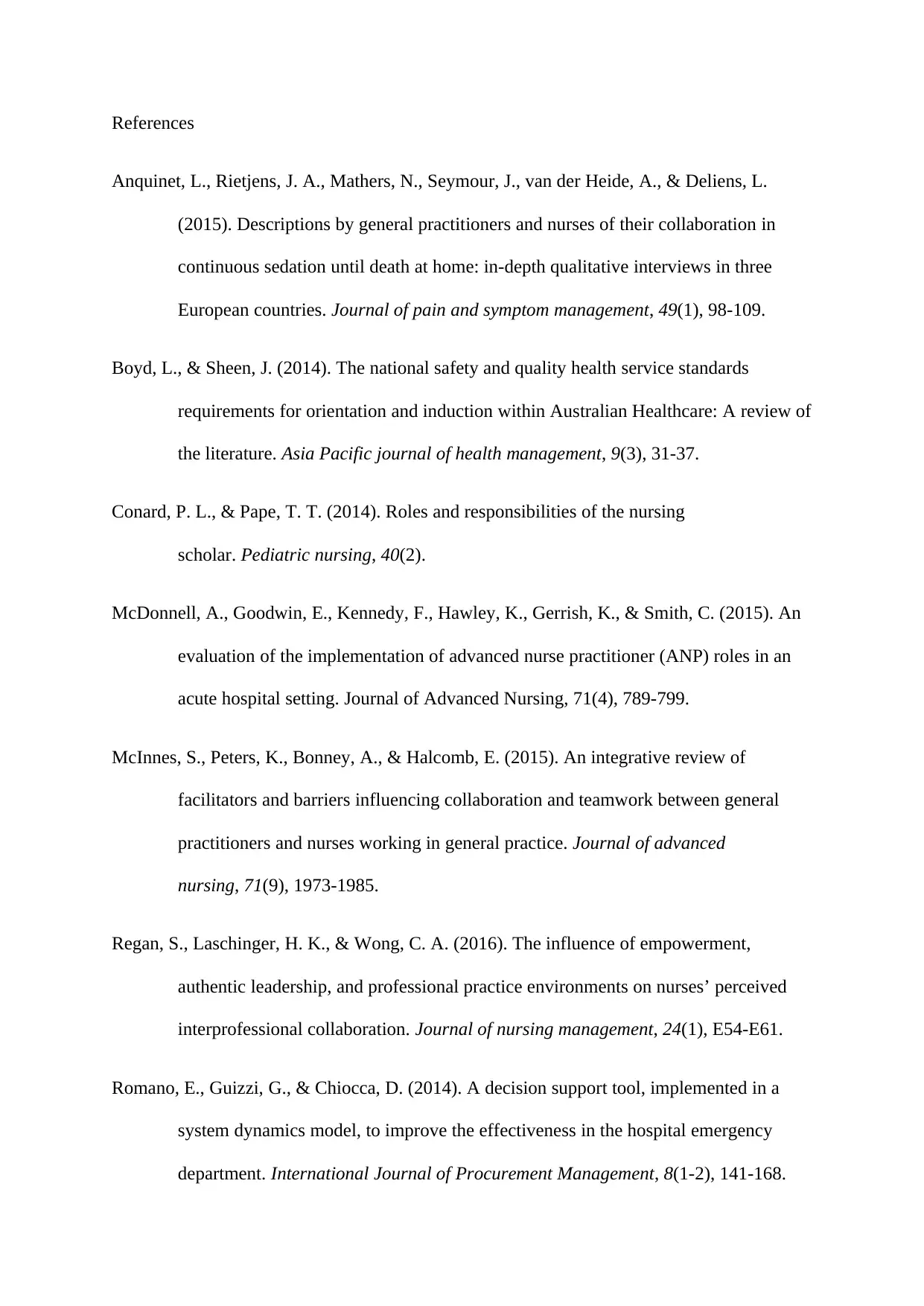
References
Anquinet, L., Rietjens, J. A., Mathers, N., Seymour, J., van der Heide, A., & Deliens, L.
(2015). Descriptions by general practitioners and nurses of their collaboration in
continuous sedation until death at home: in-depth qualitative interviews in three
European countries. Journal of pain and symptom management, 49(1), 98-109.
Boyd, L., & Sheen, J. (2014). The national safety and quality health service standards
requirements for orientation and induction within Australian Healthcare: A review of
the literature. Asia Pacific journal of health management, 9(3), 31-37.
Conard, P. L., & Pape, T. T. (2014). Roles and responsibilities of the nursing
scholar. Pediatric nursing, 40(2).
McDonnell, A., Goodwin, E., Kennedy, F., Hawley, K., Gerrish, K., & Smith, C. (2015). An
evaluation of the implementation of advanced nurse practitioner (ANP) roles in an
acute hospital setting. Journal of Advanced Nursing, 71(4), 789-799.
McInnes, S., Peters, K., Bonney, A., & Halcomb, E. (2015). An integrative review of
facilitators and barriers influencing collaboration and teamwork between general
practitioners and nurses working in general practice. Journal of advanced
nursing, 71(9), 1973-1985.
Regan, S., Laschinger, H. K., & Wong, C. A. (2016). The influence of empowerment,
authentic leadership, and professional practice environments on nurses’ perceived
interprofessional collaboration. Journal of nursing management, 24(1), E54-E61.
Romano, E., Guizzi, G., & Chiocca, D. (2014). A decision support tool, implemented in a
system dynamics model, to improve the effectiveness in the hospital emergency
department. International Journal of Procurement Management, 8(1-2), 141-168.
Anquinet, L., Rietjens, J. A., Mathers, N., Seymour, J., van der Heide, A., & Deliens, L.
(2015). Descriptions by general practitioners and nurses of their collaboration in
continuous sedation until death at home: in-depth qualitative interviews in three
European countries. Journal of pain and symptom management, 49(1), 98-109.
Boyd, L., & Sheen, J. (2014). The national safety and quality health service standards
requirements for orientation and induction within Australian Healthcare: A review of
the literature. Asia Pacific journal of health management, 9(3), 31-37.
Conard, P. L., & Pape, T. T. (2014). Roles and responsibilities of the nursing
scholar. Pediatric nursing, 40(2).
McDonnell, A., Goodwin, E., Kennedy, F., Hawley, K., Gerrish, K., & Smith, C. (2015). An
evaluation of the implementation of advanced nurse practitioner (ANP) roles in an
acute hospital setting. Journal of Advanced Nursing, 71(4), 789-799.
McInnes, S., Peters, K., Bonney, A., & Halcomb, E. (2015). An integrative review of
facilitators and barriers influencing collaboration and teamwork between general
practitioners and nurses working in general practice. Journal of advanced
nursing, 71(9), 1973-1985.
Regan, S., Laschinger, H. K., & Wong, C. A. (2016). The influence of empowerment,
authentic leadership, and professional practice environments on nurses’ perceived
interprofessional collaboration. Journal of nursing management, 24(1), E54-E61.
Romano, E., Guizzi, G., & Chiocca, D. (2014). A decision support tool, implemented in a
system dynamics model, to improve the effectiveness in the hospital emergency
department. International Journal of Procurement Management, 8(1-2), 141-168.
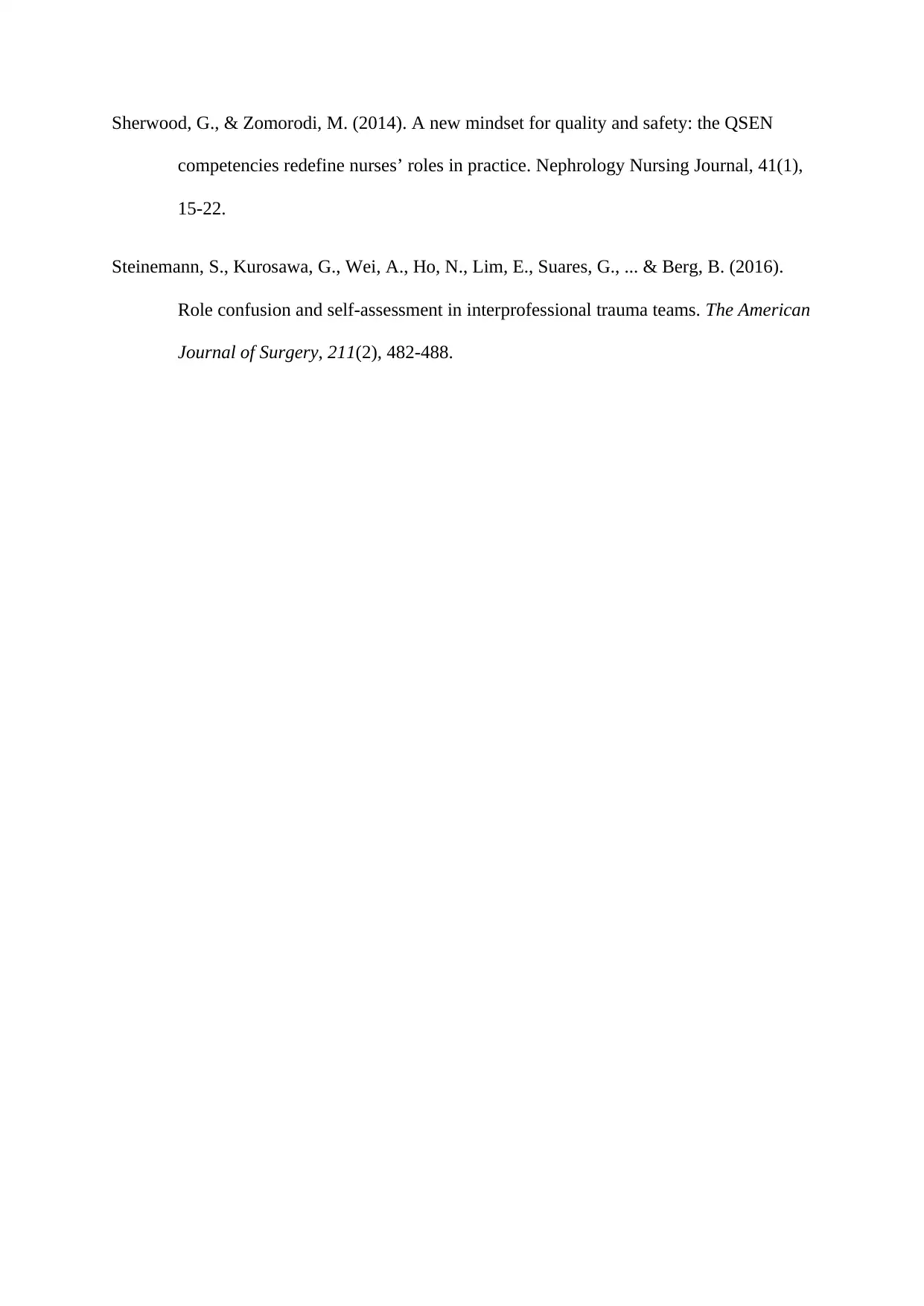
Sherwood, G., & Zomorodi, M. (2014). A new mindset for quality and safety: the QSEN
competencies redefine nurses’ roles in practice. Nephrology Nursing Journal, 41(1),
15-22.
Steinemann, S., Kurosawa, G., Wei, A., Ho, N., Lim, E., Suares, G., ... & Berg, B. (2016).
Role confusion and self-assessment in interprofessional trauma teams. The American
Journal of Surgery, 211(2), 482-488.
competencies redefine nurses’ roles in practice. Nephrology Nursing Journal, 41(1),
15-22.
Steinemann, S., Kurosawa, G., Wei, A., Ho, N., Lim, E., Suares, G., ... & Berg, B. (2016).
Role confusion and self-assessment in interprofessional trauma teams. The American
Journal of Surgery, 211(2), 482-488.
⊘ This is a preview!⊘
Do you want full access?
Subscribe today to unlock all pages.

Trusted by 1+ million students worldwide
1 out of 6
Related Documents
Your All-in-One AI-Powered Toolkit for Academic Success.
+13062052269
info@desklib.com
Available 24*7 on WhatsApp / Email
![[object Object]](/_next/static/media/star-bottom.7253800d.svg)
Unlock your academic potential
Copyright © 2020–2025 A2Z Services. All Rights Reserved. Developed and managed by ZUCOL.





